Superior Education
EMBROIDERING WITH METALLIC THREAD
- EMBROIDERY
- METALLIC THREADS
One of the most common problems, even for the most experienced machine embroiderer, is successful stitching with metallic thread. We’ve experienced it all: fraying, looping, tension problems, and continual thread breaks are enough to discourage anyone and it’s such a shame for two reasons—- everyone loves a bit of bling that metallic thread offers, and second, absolutely anyone with any machine should be able to stitch, sew, or quilt with metallic threads successfully! So, at this time of year, when all is shimmering outside, let’s take it step-by-step and highlight the process of embroidering a snowflake with gorgeous metallic thread while recommending solutions to common problems.
Start off by making sure your machine is set up correctly (this only takes a few minutes) and you’ll be
stitching with metallic thread happily for hours. We’ll examine three areas where metallic thread can get
snagged up:
#1 - At the spool (or cone)
#2 - Inside your machine
#3 - At the needle
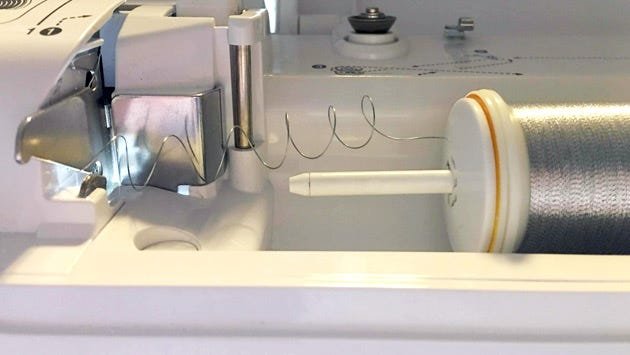
Metallic thread will curl when unwound off the end
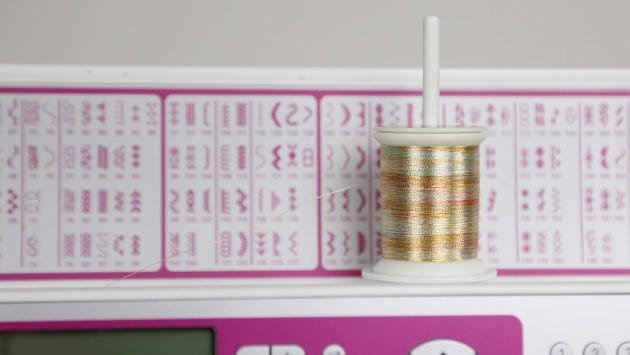
Spools of metallic thread should unwind from off the side
Starting with the spool on the machine, what's wrong with the first picture? Curls may have made for a great 80s hairstyle, but you’ll be tearing your hair out if you see this happening during embroidery. If you’ve ever experienced twisting in your thread while hand sewing, your thread can twist a tiny bit with each little stitch until you end up with a kinks and big knot. Now imagine the same process with a machine running at over 1,000 stitches per minute! It’s no wonder why metallic thread breaks when this extra twist is added with every stitch. So how do you straighten the thread out? Thankfully, it’s really easy. Spools of thread that are stack wound (also called parallel wound) should always unwind off the side of the spool. Cones of thread should only unwind over the top.
When stitching with a spool of Metallic thread, use the vertical spool pin. If your machine doesn't have a vertical spool pin, we recommend using the Superior Thread Holder when embroidering with cones and spools of metallic thread.
Now let’s think about what is going on inside an embroidery machine, specifically what happens as thread passes through the tension discs. Most embroidery machines have electronic automatic tension and it’s preset from the factory to run a generic embroidery thread. As smart as your machine is, it has no way to tell that you are stitching with a metallic thread instead of a standard polyester embroidery thread. We recommend loosening your top tension (override your automatic tension settings) all the way down to 1.0. Metallic thread is one of the most delicate threads due to its unique construction, so a loose top tension is required for frustration-free stitching. Friction and metallic threads do not make a good mix. Refer to your machine’s manual to learn how to override the default tension settings.
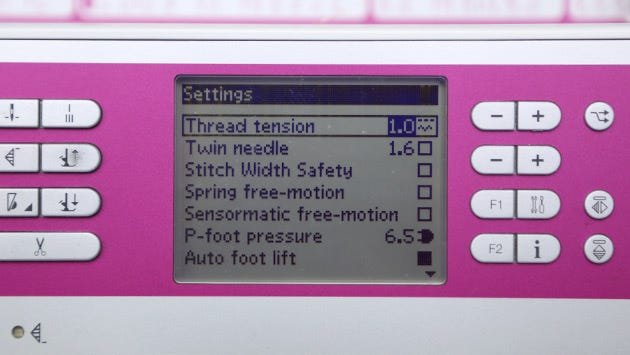
Loosen your machine's top tension setting to 1.0

A #75/11 embroidery needle is a tight fit for metallic thread
The way metallic thread is made follows a unique process. Strands of thin metal foil are delicately adhered to a film and wrapped around a strong nylon core. When embroidering, you have a high number of stitches per minute rapidly creating tiny stitches in a dense design. The thread is moving back and forth through the eye and groove of the needle, rubbing against the metal surface in a fast manner. All it takes is for the delicate metallic foil to break, and only the nylon core will be moving through the eye, as your beautiful metallic overlay starts to push back up into the machine. Again, thankfully the solution is very easy: use a needle with a larger eye and deeper groove. We recommend using a Topstitch #90/14 needle. Superior Topstitch needles have a longer and wider eye, deeper groove to protect thread during stitch creation, and a thin layer of titanium-nitride that resists friction and keeps your needle sharper much longer. Compare the Topstitch style (gold-colored needle in the picture below) to any of your embroidery needles and you’ll see the difference. Having more space in the eye of the needle helps reduce the stress placed on the thread as it passes at a high rate of speed through the needle and creates a stitch.
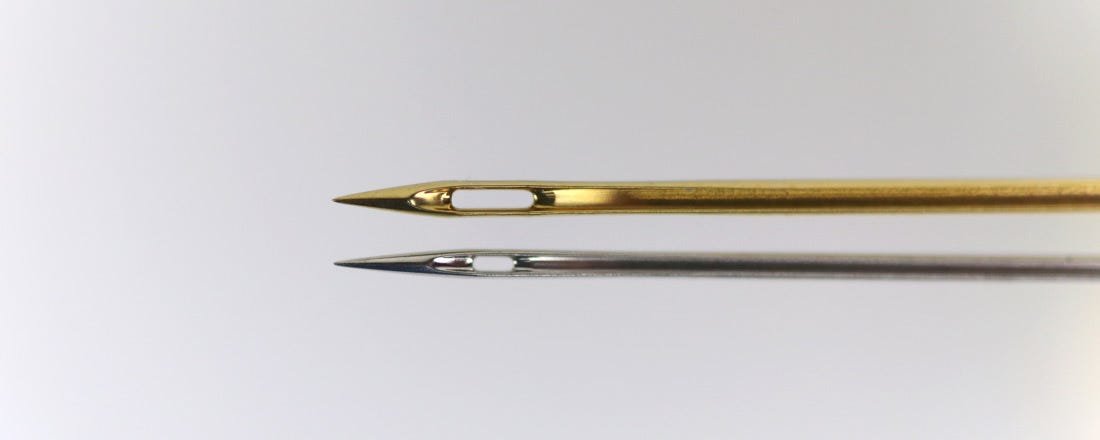
Topstitch needles have a much larger eye than Embroidery needles
Now that we have addressed the most common problems and recommended solutions to each problem, we’re ready to stitch! Starting with Silver and look at that – not even one thread break in 3,500 stitches! It’s time to take it up a notch and have some colorful fun. If you think of metallic threads as just silver and gold, you’d be wrong. There is an entire spectrum of metallic thread colors waiting for you to try, now that you know how.
We just had to use several different colors for the design because no two snowflakes are alike, right?! Look at the first completed snowflake below.
Now that you have become a metallic thread master, look for opportunities to showcase them in your embroidery, quilting, and sewing projects. You will find that metallic threads add a lot of dimension to a stitched design when mixed with other types of threads, such as this Blue Jay that was stitched with Superior Magnifico polyester thread. The blue metallic thread was almost an exact match for the blue color of polyester that was called for in the design.

Finished snowflake design with Superior Metallics

Magnifico and Superior Metallics combined
We substituted the blue metallic thread for a blue polyester thread, and the Blue Jay’s crest now has a glorious shimmer as he looks over the snowy mountain. Remember to loosen your top tension when stitching with metallic thread, then tighten it back up when stitching with regular embroidery thread. There’s no need to change needles, as the Topstitch #90/14 needle is perfect for Magnifico as well.
Watch our video on Metallic Embroidery.
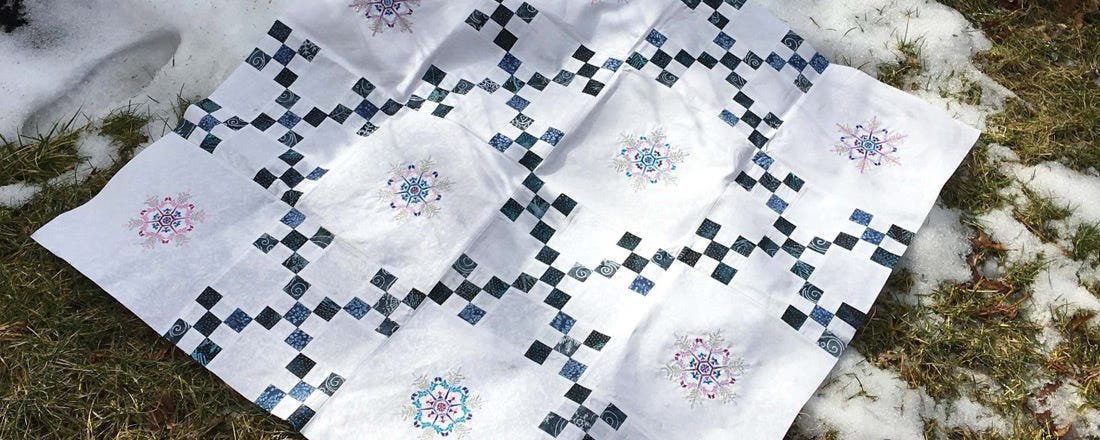
The snowflakes and Blue Jay designs are from San Francisco Stitch Co. To learn more about their fun, fresh, and exciting designs, please visit their website.

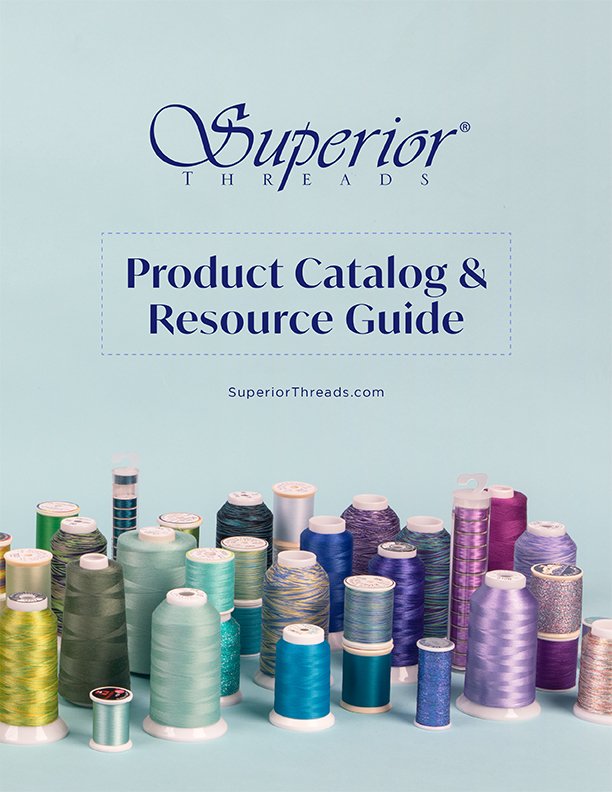 View Our Product Catalog
View Our Product Catalog